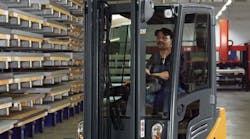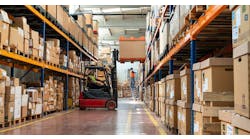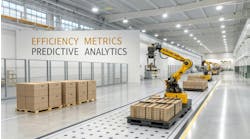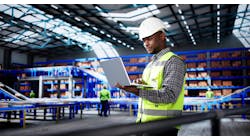A continuing tight labor market and rapidly evolving technology dominate the concerns of supply chain managers in North America for what they see coming this year if the views of a panel of executives assembled by the Warehouse Education and Research Council (WERC) prove right.
But those same executives see developments in technology providing powerful and revolutionary solutions, both those that will gain ascendency this year and others that may seem like little more than science fiction today but can be expected to prevail in the years to come.
WERC is the professional education and research association for logistics management professionals. Because it does not get involved in lobbying or other political and government policy advocacy, its sole focus is education, as can be seen by the agenda of its annual conferences, the next of which will be held May 3-6 in Providence, RI.
Members are drawn from executives for private companies like manufacturers and retailers who operate their own warehouse and distribution facilities and services, along with third-party warehouse logistics companies that provide clients with warehousing, distribution and other services ranging from transportation to supply chain management.
Members of the WERC forecast panel believe that labor issues – specifically those surrounding the shortage of qualified workers – will continue to be a major issue for warehouses and distribution centers in 2020 and beyond.
“Salary comparisons and adjustments where necessary will be key to hiring and retaining strong workforces,” notes Dan Beard, senior director of distribution for NexTerra Wine Company. He also says management also can be expected to put an increased emphasis on improving and strengthening culture as another step toward mitigating that challenge.
The same holds true for Canada, according to David Singer, senior vice president at Thomas, Large & Singer, a 3PL based in Markham, Ontario, who notes that in his local market unemployment is at the lowest rate it has been in more than 40 years.
“Not only will that continue to drive wages higher, but employee churn will also still be an issue. That will make it even more imperative that warehouses and DCs find ways to increase efficiency — particularly as they add services that drive greater value for their clients, like co-packing, labeling, kitting, and direct-to-consumer deliveries,” he explains.
“I expect that, as an employee retention strategy, operations will link workers to efficiency. We’ll see expanded tracking of labor and incentivizing higher performance with rewards based on key performance indicators (KPIs) that employees are accountable for meeting.”
Jeremy Banta, professor of supply chain management at Columbus State Community College, also says that improving culture as a workforce strategy is something he expects to see more of in 2020. He cites some facilities in central Ohio that have dedicated a corner of their warehouse to a basketball court, ping pong tables and even set up a gym for their employees, amenities are no longer limited to Silicon Valley tech startups.
“Of course, you can offer all this neat stuff, but if you don’t make people feel like it’s okay to use it, then it’s useless,” Banta adds. “If, by 2020, companies haven’t realized that corporate culture is an issue, then shame on them. It’s got to come from the top down.”
Brad Long, brand marketing manager for Yale Materials Handling, agrees. “The labor shortage and turnover rates pressure operations to re-examine their strategic workforce planning, with a keen interest in technologies like robotics and connected Internet of Things (IoT) solutions, as well as hiring and retention activities. The focus is to make the most effective use of labor resources that are available.”
Further compounding labor challenges are customers’ fulfillment expectations, he points out.
“On average, 69% of customers will not shop with a company again if their delivery is late. With stakes this high, speed, agility and quality are imperative to get customers their orders correctly and quickly.”
SKU proliferation also will continue into 2020, as the number of distinct items companies produce and consumers demand continues to rise, Long predicts. “Businesses must respond by adjusting their facility layouts and optimizing their workflows to accommodate.”
The continuing shortage of qualified truck drivers adds to the labor crunch, and will persist in causing sleepless nights for supply chain managers, says Aaron Wilker, managing partner at C2 Logistix, a warehouse-based 3PL headquartered in Livermore, CA.
“It was a hot topic at the 2019 WERC Annual Conference, and I’m sorry to report that nobody had a solution that was guaranteed to get drivers,” he declares. “I’ve even been trying to get my 25-year-old son, who didn’t like college, to go get his Class A – he could be making six figures within two years!”
Tech Offers Opportunities
Distribution leaders will continue to invest in the systems that deliver improvements in safety, productivity, and efficiency, which has driven an increase in supplier partnerships that enable users of key management software to leverage Cloud and mobile platforms, Beard says.
“Advancements in mobile technologies for the warehousing, distribution and transportation sectors have grown significantly in the last few years, and I believe we’ll see wider adoption of iOS and Android-based applications for warehouse management in 2020.”
Wilker also anticipates that more operations will shift from site-hosted to Cloud-hosted software, including enterprise resource planning (ERP), warehouse management systems (WMS), and transportation management systems (TMS). “For companies with a sales force that absolutely depends on accurate inventory, the ability to share real-time updates via Cloud-based software is a game-changer.”
Wilker believes automated systems will also be increasingly implemented in 2020, but selectively, in the areas where they increase productivity and support the bottom line He adds that companies who hesitated to invest before now are finally seeing quantifiable successes from early adopters, which makes the capital investment more appealing.
“I’ve been seeing a lot more interest in automatic guided vehicles (AGVs) and autonomous mobile robots (AMRs) to interface with conveyors and move pallets or products as a supplement to the manual labor force,” he explains. “Likewise, systems that increase accuracy and minimize labor touches for inventory picking and putaway – such as automated storage and retrieval systems (ASRS) and augmented reality visual headsets – will likely see more installations as well.”
Both Singer and Long concur, noting that robotic lift trucks used for any task that involves picking up, transporting and dropping off pallets have been getting a lot of recent attention.
“They improve efficiency by optimizing workflow, offering greater dependability and enhancing labor productivity,” says Long. “When used as part of an operations’ strategic workforce planning, robotic lift trucks can augment available labor resources, fostering ‘cobotics’ with humans working alongside robots. This leverages the strengths of both to make repetitive tasks and more complex, value-added functions more efficient.”
Automation implementations definitely offer DCs increased productivity with less labor pressure, but Chaneta Sullivan, director of safety, quality and compliance at Chick-fil-A Supply, cautions that companies need to remain focused on ensuring a safe working environment for those employees who continue to work in the facility.
“Obviously, Occupational Safety and Health Administration (OSHA) citations and inspections are on everyone’s radar, but recent OSHA communications continue to show a high focus and citation rate for workplace accidents and injuries involving machinery, machine guarding, lockout/tagout, fall protection, and more” she observes. “The resulting fines have been huge, in the hundreds of thousands of dollars, and could cripple a company if the injury is significant enough.”
Sullivan says some of that uptick to increases in automation installations over the past few years. “My concern is that companies aren’t necessarily focusing as much as they should be on putting the proper protection around this equipment, like machine guarding, as well as on the importance of training. Both should be a big part of a company’s culture. Adding efficiencies to warehousing can be very beneficial, but any labor and/or financial benefit will be insignificant if we forget to train our people the right way and ensure they enjoy the ability to go home the same way they came to work. Brand reputation and having a true culture of care trumps everything.”
As someone involved in one part of the food supply chain, Sullivan also expects to see increased use of technology in the food tracking and traceability arena this year. Doing so further expands visibility into the entire food supply chain from end-to-end, an imperative factor to protecting consumer trust, she explains.
“In a highly regulated environment, any technology that can be used to track product source, condition, and safety particularly its time and temperature from end-to-end, is key. We are currently exploring technology which will provide enhanced visibility and dashboard capabilities to ensure we maintain the highest standard of care and quality for our supply chain and the food we ship every day.”
She cites the example of being able to use that real-time visibility to reroute a problem shipment before it arrives at its destination, as well as afforings the opportunity to correct the issue safely and appropriately.
2020 and Beyond
Singer points out that in 2020 customers also will continue to expect greater visibility into live, actionable, real-time data. “Operations recognize the need for improved data services and reporting functions, particularly as retailer supply chain requirements and penalties grow in scope and complexity. I think we’ll see more companies meeting their customers’ expectations for the ‘app’-like accessibility to information on demand, which has become so prevalent in our day-to-day lifestyles and culture.”
Lots of technologies have been hyped for their potential to benefit supply chains, but questions arise about whether any of them are at the point of practical application or rapidly approaching it. Wilker cites Blockchain as an emerging supply chain technology that companies which are heavily involved in importing or exporting products should devote more attention to in 2020. The tracking benefits of Blockchain will be a big efficiency booster, he argues.
“It also makes ownership instantaneous. When a shipment is loaded onto a ship, the documentation is automatically updated. The same happens when the load transfers to intermodal and so on. Every time ownership of, or responsibility for, a shipment changes hands, Blockchain tracks it and payment can also be transferred immediately. Everybody wants to get paid faster; Blockchain enables that.”
As the importance of transparency and sustainability continue to grow among consumers, operations will start to look at alternative power sources for their motive fleets, especially electric powered vehicles, Long asserts.
“Lithium-ion batteries, for example, offer superior performance and require zero maintenance in order to charge -- just plug in whenever the opportunity presents itself,” he says. “They also last longer than traditional electrification options. Over a five-year period, a single lithium-ion battery pack would allow operations to avoid replacing four lead acid battery packs. This reduces recycling waste and saves money.”
Long also observes that hydrogen fuel cells, once considered cost prohibitive, are becoming more affordable, making them a legitimate option to improve operational performance. “They produce no harmful emissions, only water and heat, and can be refueled in as quick as three minutes. This enables a significant reduction in greenhouse gases, while enabling operations to maximize productivity, with minimal downtime for refueling.”
As for what is coming after 2020 runs its course, Banta encourages companies to start thinking longer term about two future transportation modes: commercial space travel and Hyperloop. “Those two things are heating up fast. Are either of them going to happen in the next two to three years? No. However, what happens if a commercial space program approaches your company about using your product in zero gravity?”
Hyperloop, a transportation method that moves passengers or freight in pods at extremely high speeds through a sealed tube system at significantly reduced travel times, also has the potential to impact supply chains, Banta says, even if it may seem a bit far-fetched now.
“There’s been more change in our industry in the last five years than in the previous 30. Changes that used to take decades to happen now occur in months,” he stresses. “If you aren’t staying educated on trends and emerging technologies and how businesses are adapting, you could find yourself too far behind and unable to recover.”




